Intermodellbau Dortmund 2007
Intermodellbau is like no other model show. In fact it is more an experience and this year was no exception. My brief is of course to see what is new on the warship scene and this show never fails. This year there were a good crop of interesting exhibits and displays and as it is an international event, this was reflected in the models.
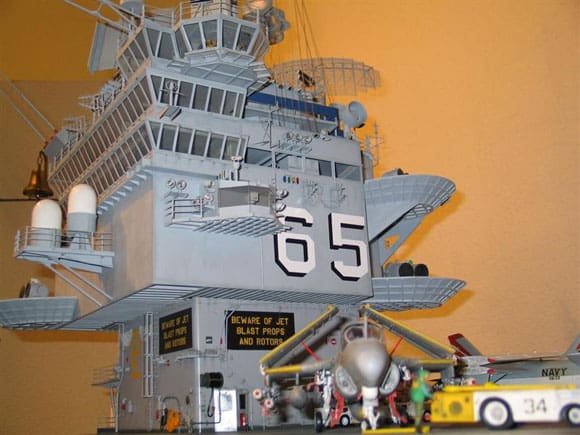
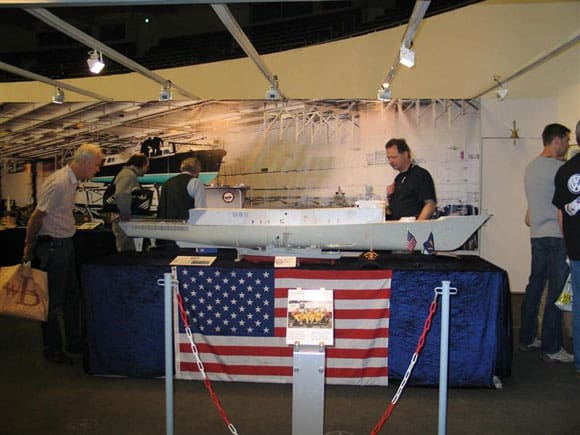
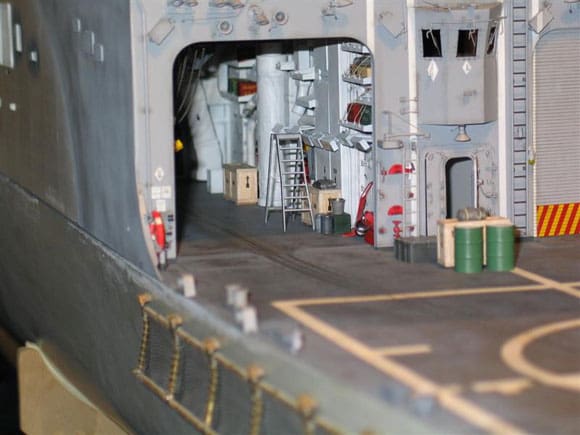
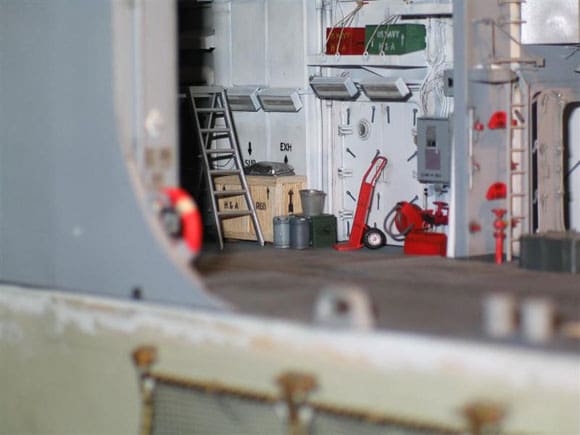
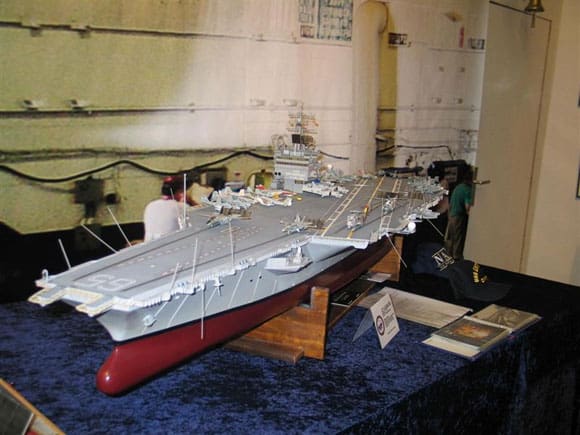
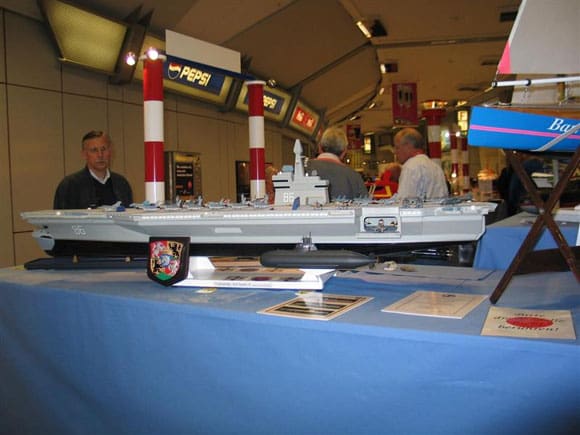
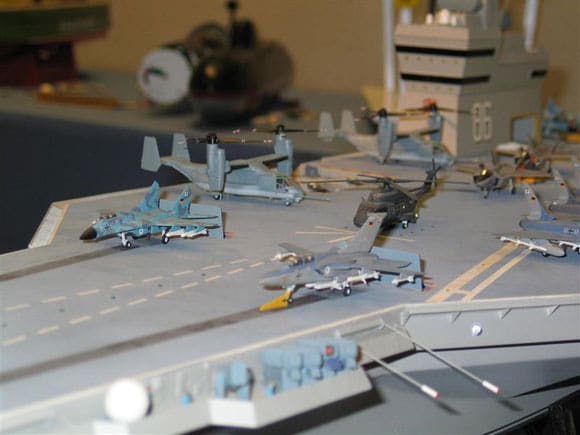
Pic 1: The island superstructure for a 1:48 scale Enterprise. Pic 2: Scale Navy Stand with their 1:48th FFG USS Robert G Bradley. Pic 3: A highly authentic hanger interior of the Robert G Bradley. Pic 4: Close detailing as per the real ship even down to such mundane items as stepladders. Pic 5: The smaller version of the big ‘E’ at 7ft long and 1:144 scale. Pic 6: An idealized modern German CV Graf Zeppelin. Pic 7: A rather mixed bag of an air group for the Graf Zeppelin.
Scale Navy
As you arrive in the boat hall you are confronted by this display stand, which is designed to give the appearance of the interior of an aircraft carrier hanger and is devoted to warships of the USN, particularly carriers. The stand is organised by a team going under the name Scale Navy and they even make the models of TF72 look small by comparison, as many of their models are built to a scale of 1:48. Scale Navy first attended two years ago with the island superstructure of CVN 65 at 1:48 scale being the centrepiece of the display.
Enjoy more Model Boats Magazine reading in the monthly magazine.
Click here to subscribe & save.
CVN 65 island was back as shown in photo1, but the centre of attraction was an in build 1:48th model of the USS Robert G. Bradley, an Oliver Hazard Perry Class FFG, photo 2. There were some interesting statistics; for example the length and beam of the model are 289cm x 28.5cm and she weighed in at 40kgs. However, the detail already incorporated into this model is quite superb, in particular the interior of the hanger, photos 3 and 4. However not all the displays are at 1:48. There was a small (not that small) 7ft, 1:144 USS Enterprise, photo 5.
A Modern German ‘CV’ Graf Zeppelin?
Remaining with the carrier theme I couldn’t help noticing an unfamiliar model on one of the club stands in the circular rotunda. I recognised the crest, but expected to see a very different type of model, photo 6. This was a interesting impression of how such a German aircraft carrier might appear. Although this Graf Zeppelin was make believe, at 1:144 scale it made for quite a striking model. Having a look at the air wing made for some interesting combinations, like an X35 Lightning, Tornado, Mig 29, MV22’s, Osprey Tilt Rotor assault troop carrier and a navalised Euro-Fighter. Who knows, the builder may be closer to the truth than we would ever know, photo 7.
U-boats and a D-Day Diorama
Viewing the club stands always brings up some nicely turned out models and this model of a Type1XC Flak, photo 8 and this group of submarine modellers deliberating over a Type XX1, photo 9. One of the largest static displays was by a group of modellers from Belgium using working models to set a scene from Operation Neptune. A diorama depicting sections of the Mulberry Harbour known as whales being towed across the channel, all to a scale of 1:96 – an interesting modelling concept, photo 10.
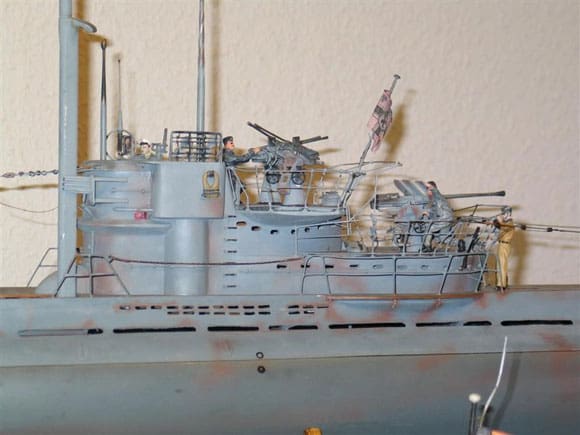
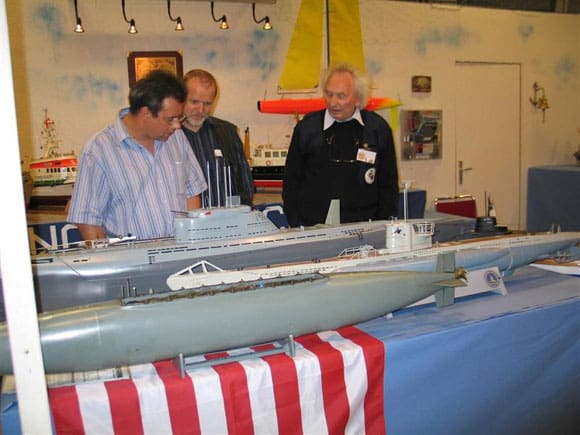
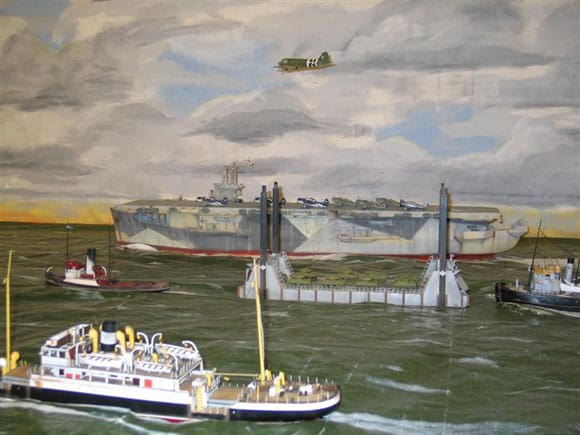
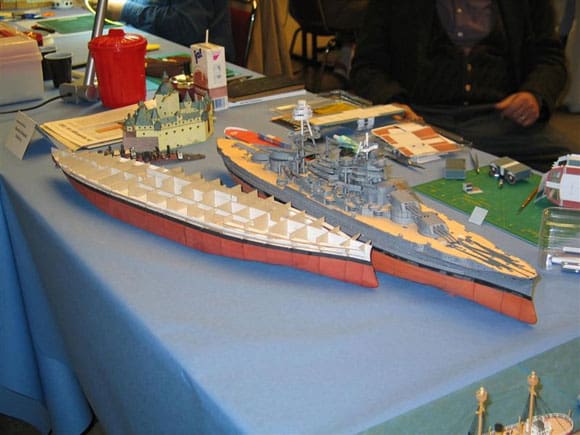
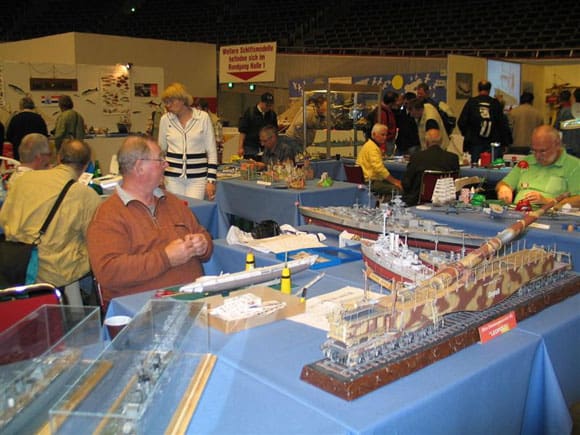
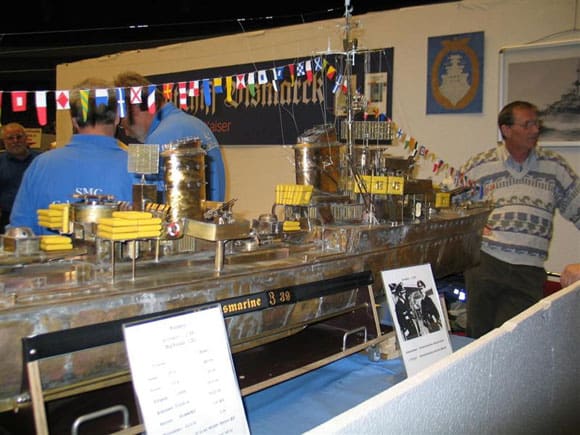
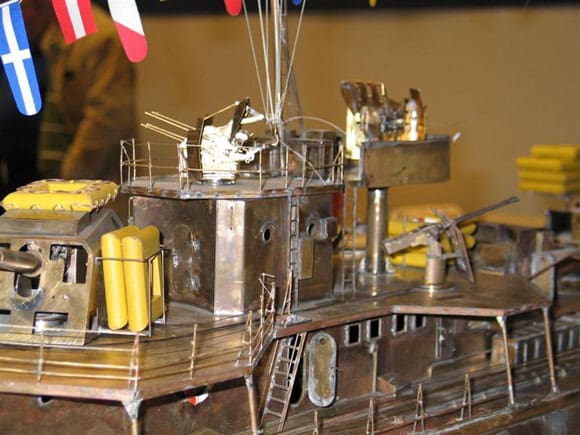
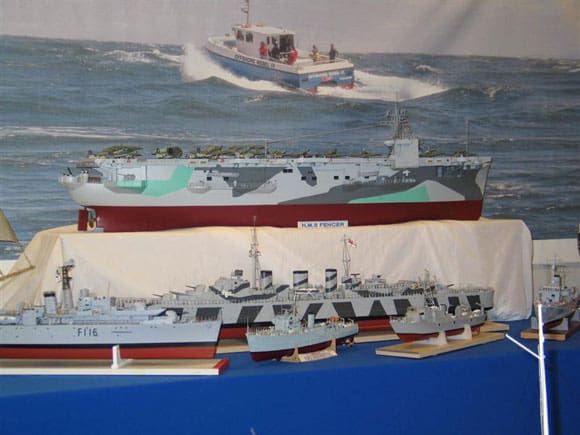
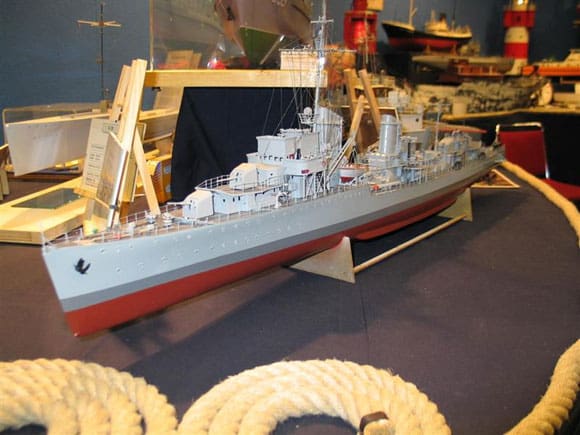
Pic 8: A type 1X C Flak. Pic 9: Submarines are a popular form of modelling at Dortmund. Pic 10: A large and unique diorama of operation Neptune and the moving of the Mulberry Whales across the channel. Pic 11: A stunning USS Arizona, all in card. Pic 12: Card Modelling at its very best from such diverse subjects as ships to rail guns. Pic 13: An all brass 1:35 scale Z39 German destroyer. Pic 14: The after superstructure and gun fit. Pic 15: The Peterborough MBC Stand – a great back drop. Pic 16: Another German destroyer Z13 but at 1:100 scale. Pic 17:A well-detailed bridge area on Z13.
Card modelling
Without fear of contradiction, German modellers have a long standing interest in card models and now with the ever-increasing use of photo etching, the models reach very high levels of detail like this model of the USS Arizona, photo 11. The broad interest base is seen here with this magnificent Leopold rail gun in the foreground and in the background is an equally superb KM Bismarck, photo 12.
An all brass 1:35 Z 39
When it comes to large model ships this Z39 German destroyer built entirely in brass by Wolfgang Beu doesn’t come much larger, at 362cm in length x 31cm in beam, photo 13. Neatly arranged are a number of photos showing the model on the water. Given this fact, it’s amazing that it has retained its original brass appearance, and here is another picture of the after superstructure complete with Quad 2cm AA platform to prove it, photo 14.
Peterborough MBC
Now very much part of the fabric of the Intermodellbau, is Peterborough MBC who consistently please their German hosts each year by reinvigorating and improving the club stand, photo 15.
Z13
Back to the German destroyer models on display. Here are two pictures showing a superbly built model of Z13, the Type 1934 destroyer Erich Koellner to a scale of 1:100, measuring 119cm long x 11.3cm beam, photo 16. The fine detail work around the bridge exemplifies the care taken by Heinrich Kollmar in the building of this model, photo 17. On the historical side the original was destroyed at Narvik by the gunfire of HMS Warspite, and the destroyers HMS Eskimo, Bedouin, Punjabi and Icarus.
More of Josef Kaiser’s Bismarck
No review of the club stands would be complete without another look at Josef Kaiser’s magnificent Bismarck. This time a view towards the armoured conning position and bridge, photo 18.
Trade stands
Robbe’s all new submarine U-31, photo 19 was on display on their stand. The proper presentation of new models is a well-entrenched feature of the Intermodellbau and this year was no exception. For those amongst you with an interest in full size modern German U-boats, particularly these Type 212A attack submarines. These conventional boats are quite something and have AIP (air independent propulsion) with a metal- hydride fuel cell system. For emergency surfacing ,the tanks can be blown by using hydrazine gas generators and one of the interesting if not controversial features is the lack of compartmentalization within the pressure hull, with the aim of reducing noise and improve silencing. The combat systems have the capacity to track no less that 25 targets simultaneously.
Graupner SMS Emden
Moving on, that erstwhile giant of the German modelling industry, Graupner, presented their new products intended for release over the coming year. First amongst these was the pride of Von Spee’s East Asiatic Squadron, the legendary SMS Emden at 1:96 scale. Like many of Graupner’s new r/c boat models, Emden is classed as almost ready to run photo 20. The level of detailing is going to take some beating, as this picture of the bridge will testify, photo 21. It now appears that ready, or near ready to run, is fast becoming a sales pitch of all of the major players on the r/c boat side of the German model industry, mirroring, perhaps that of the ready to fly models, which have proved to be an enormous success. However, providing models that remove the chore or fun of building is a mute point, but only time will tell if this is indeed the right move. It would be interesting to get some feed back on this very subject – what’s your opinion?
TJ Models
TJ Models is a model company based in China and attended Intermodellbau for the first time displaying a number of their new r/c products, in particular this 1:200 model of the battleship USS New Jersey. I’m not clear as to whether these models come complete or as some form of kit. None the less they are superbly made and would not be out of place as static models, photo 22.
Part 3 – Flexible Support Ship Esbern Snare
Last month we concluded our tour adjacent to the funnel casings on what would be 02 decks. In this concluding part we can move to take a close in look at the enclosed and shuttered sides of the hull, photo 23.
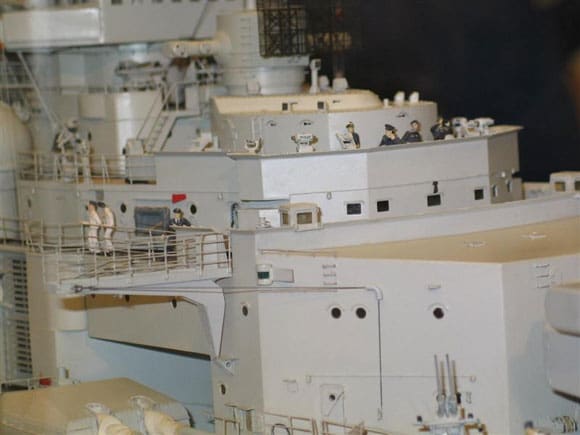
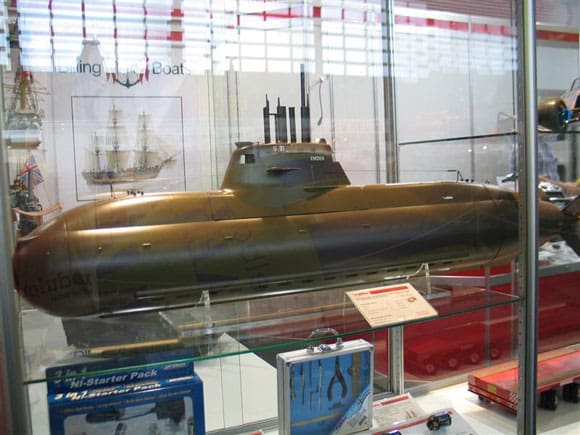
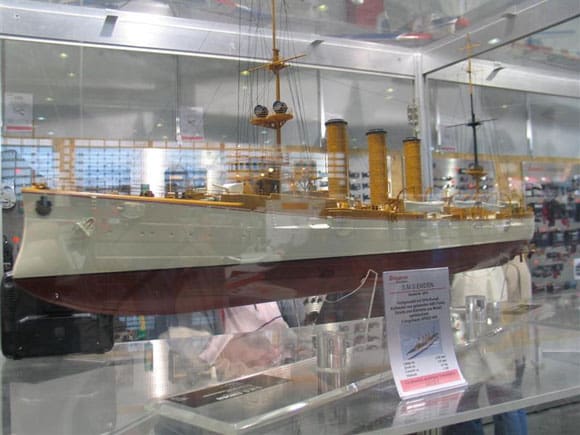
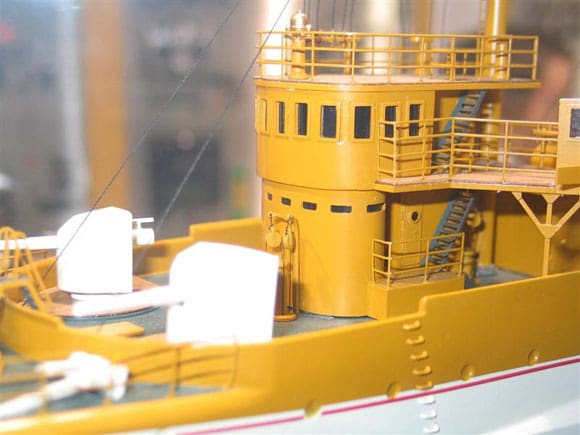
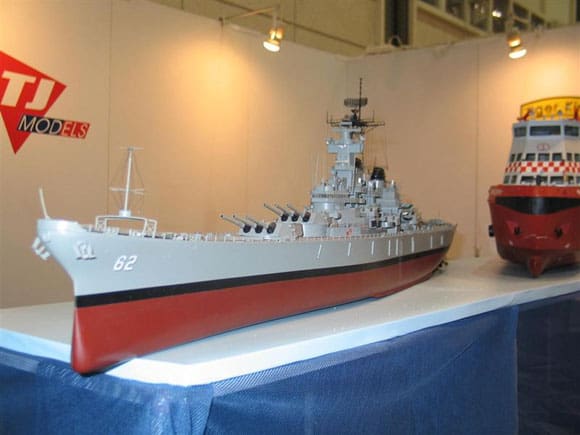
Pic 18: Bismarck and Joseph Kaiser are very much part of Intermodellbau. Pic 19: U31, new from Robbe. Pic 20: A 1:96 scale, almost ready to run (ARTR) SMS Emden. Pic 21: With Graupner’s new Emden some compromises have had to be made, but the detail remains fairly accurate. Pic 22: TJ Models from China displaying their new products, which includes this rather nice BB62, USS New Jersey. Whether these are almost ready to run or in kit form remains unclear.
Liferaft Chute
Fittings like ship’s boats, liferaft chutes and in fact any fitting that protruded clear of the hull or superstructure could provide a radar return and thus negate any of the advantages that angled surfaces give to the ship’s passive defence systems. Thus, on the Esbern Snare, essential life preserving fittings such as the liferaft containers have to be built into the ship, an example of this methodology can be seen in photo 24. The frame and mechanism for the release of the canisters can be seen in photo 25.
Refuelling at Sea
The equipment for refuelling at sea (or RAS) in the conventional sense is usually found on the main deck or anchored to part of the superstructure and invariably uses some form of a vertical hoist. However on ships where stealth is as much part of the ships defensive net as ECM (Electronic Counter Measures), the RAS equipment, like that of the liferaft chutes is concealed behind shutters. An example of this can be seen in photos 26 and 27.
Concealed RIB
Remaining with the need to conceal equipment, the RIB (rigid inflatable boat) is also hidden behind roller shutters, not unlike those on the French La Fayette class of FFG’s or the South African Navy Valour class of Meko A200s, photo 28 to 29. Photo 30 shows how the RIBs are mounted on davits, whilst photo 31 illustrates the principles of deploying the RIB from the recessed bay. How the openings appear when viewing along the sides of the hull and superstructure can be seen in photo 32.
The Hanger
Atop of the spacious hanger on either beam are sited foam guns, the general position can be ascertained in photo 33, whilst the shape and some idea of their size can be seen in photo 34. Moving on to the flight deck, we get a good view of the hanger shutters and to port the helicopter operations station, photos 35 and 36 with the interior of the spacious hanger made visible in photo 37. Tied down on the flight deck is a Danish Navy Lynx helicopter, photo 38.
Cargo Deck
The piece de-resistance of the Esbern Snare is the 84m long by 10.5m wide and 4.5m high cargo deck which has both side and stern ramps. This is a huge area that can accommodate up to 1700tons of cargo, which can include armoured vehicles, assault landing craft and helicopters. Photo 39 gives some idea of the space available Over to port and aft, is a crane that can launch the ships LCP through a door in the stern, photo 40 and adjacent to this is the RO-RO door for shipping or discharging cargo, photo 41. Finally the openings in the stern for launching the ship’s boat and the large Ro-Ro door can be seen in photo 42. That completes this tour on the Absalon Class Flexible Support Ship Esbern Snare. I think these pictures are amongst the few that are available of this most flexible of modern warships.
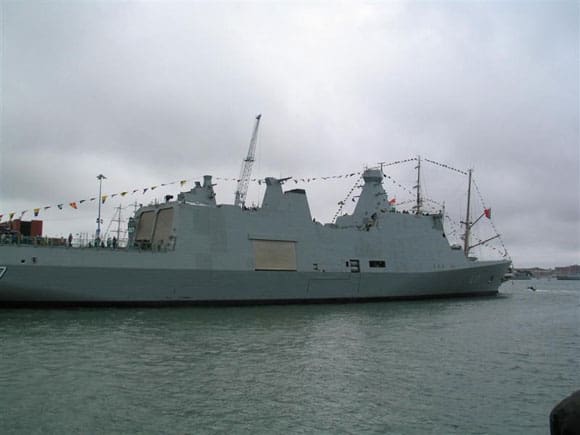
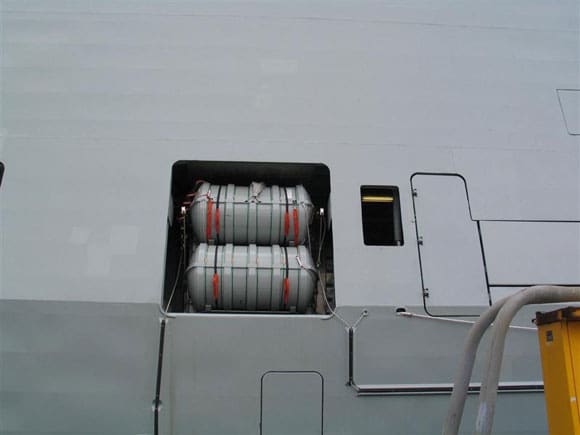
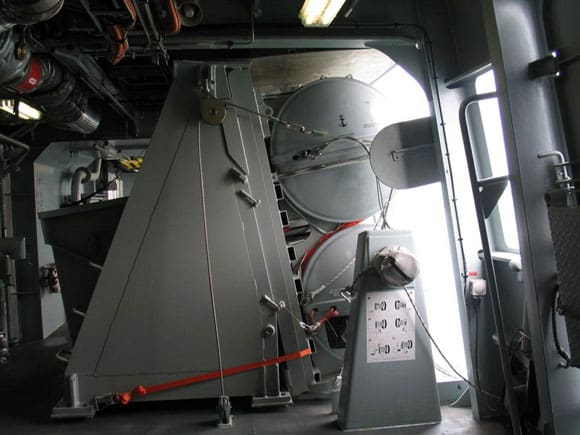
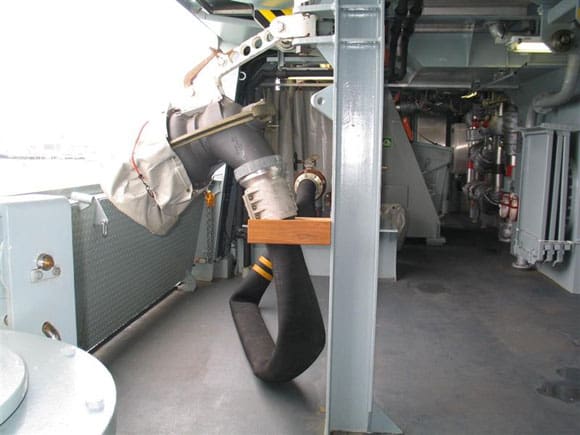
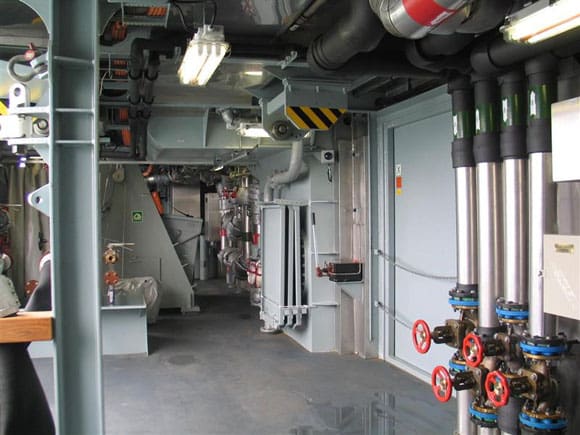
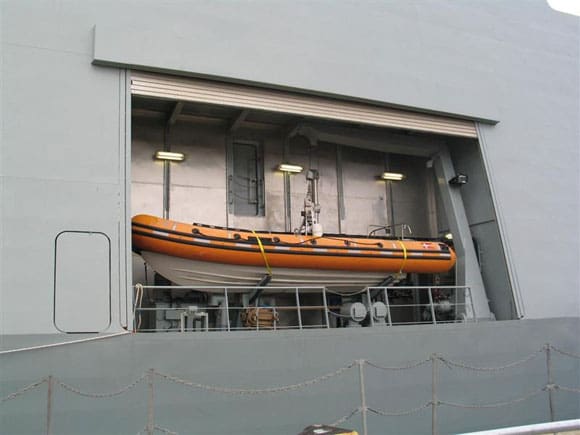
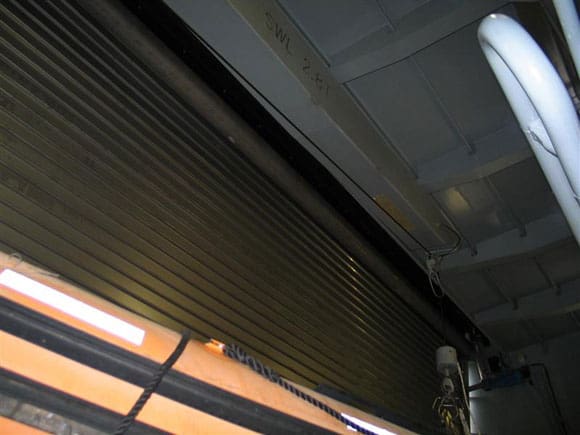
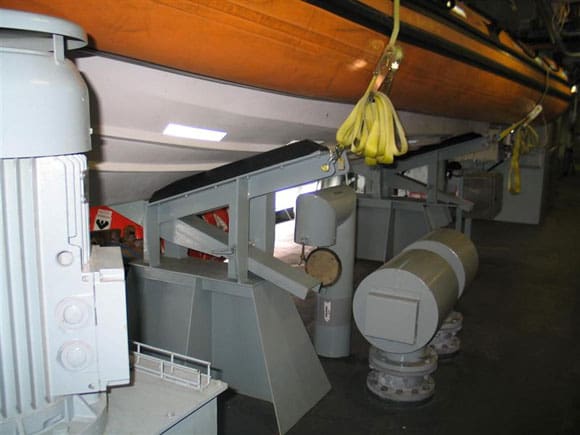
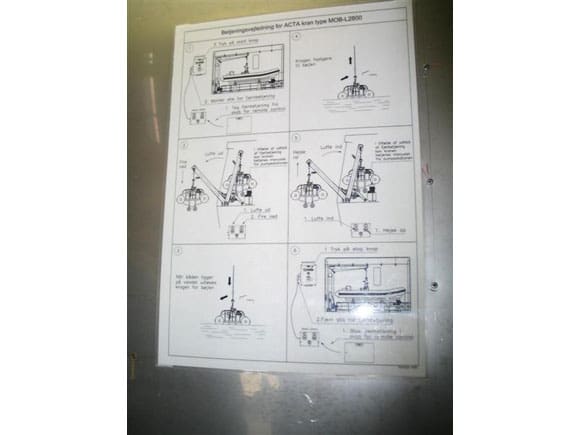
Pic 23: Starboard side views of the openings on the Esbern Snare. Pic 24: Concealed opening in the side of the superstructure for the liferaft chute. Pic 25: Storage and release mechanism for the liferaft containers. Pic 26: The RAS (Refuelling at Sea) hose. Pic 27: Part view of the RAS bay. Pic 28:RIB bay in the side of the superstructure. Pic 29:Roller shutters complete the concealment. Pic 30:How the RIB is mounted within the boat bay. Pic 31:Official launching procedures for the RIB.
The Model
Billings are ready to launch their own 1:100 kit of the Absalon, a sister ship to the Esbern Snare and from the latest information it will be available from July 07. Answer to last months Mystery Picture is HMS Iveston M1151. This of course was a give away but may not be totally so. The picture was of HMS Iveston in Malta in the November of 1955. HMS Iveston was part of the largest class of any warship produced in peacetime, if not in war. 118 were authorised, to bulk up the mine defences of the UK and our MCM (Mine Counter Measures) commitment to NATO. As it was envisaged in the early post-war years that the main threat to British and West European ports from any Soviet offensive would be through the mining of major waterways, which with the more sophisticated influence mines being developed, could deny these vital arteries to British shipping. The design called for a minesweeper that was unaffected by magnetic mines and the logical material of choice for the construction of the Ton Class was a timber clad hull, with frames of aluminium. This design at the time was probably the right one, but many were to suffer structural degradation as a result.
Iveston was laid down at Phillip and Sons, Dartmouth and launched on the 1st of June 1952, entering service in early 1955. These 440 ton vessels were equipped with two Mirrles/ Deltic 12 cylinder diesels on two shafts with a range of 2500 miles at 12kts. Up forward, as in the Mystery Picture, was mounted a single 40mm Bofors on an Mk7 mounting. The minesweepers carried 2x20mm, but the minehunter variant had only a 40mm gun fitted. Iveston was converted to the Minehunter role at Devonport between early 1963 to mid 1964 and was attached at various times to either the 1st or 2nd MCMS (Mine Counter Measures Squadron).
Answer to last month ‘What type of ship are we looking at?’ – It is HMS London. Identifying this particular ‘what type of ship’ could have raised some initial confusion, because as we shall see, not all was as it appeared.
In the years following 1918, the British along with the USA, Japan and Italy formulated a political compromise governing the size of their respective navies and the first accord was drafted in 1922 and became known as the Washington Naval Treaty. This placed restrictions for cruisers limiting the displacement to 10000 tons and a maximum of 8ins for the gun . As a result, the first of the so-called treaty cruisers laid down for the Royal Navy, post 1922, were the Kent class. The first of which, HMS Berwick was laid down at Fairfield’s on the 15 of September 1924. Five were for the RN and two for the RAN. The follow up London class were built to a similar design but were some 1600 ton lighter at full load at the expense of external bulges. HMS London, the first of the class was launched at Portsmouth on the 14th of September 1927, although she differed in some respects to the preceding Kent class in the position of bridge and funnels, the appearances of both remained close. Further refits followed, which included the addition of an aircraft catapult between 1931-1932. 1936-1937 saw additional weapon fits.
However in the March of 1939, London was taken into dockyard hands yet again to undergo major reconstruction, which included hanger facilities, new athwart ships catapult, increased AA defence and four twin 4inch mountings. Most noticeable was the profile changing alteration to the bridge, which gave an appearance not dissimilar to the Fiji or Colony class of light cruisers. London was to under go more refits, focused on improving overall air defences. culminating by the end of the war with a mixture of single and twin 20mm guns, plus six single 40mm mounts. London had the dubious distinction of being the first of the London class to be scraped in 1950.
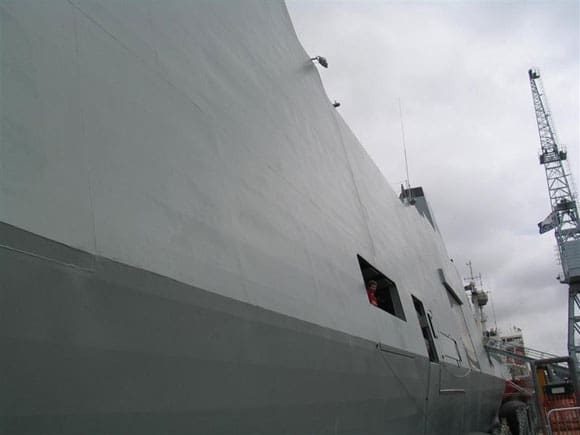
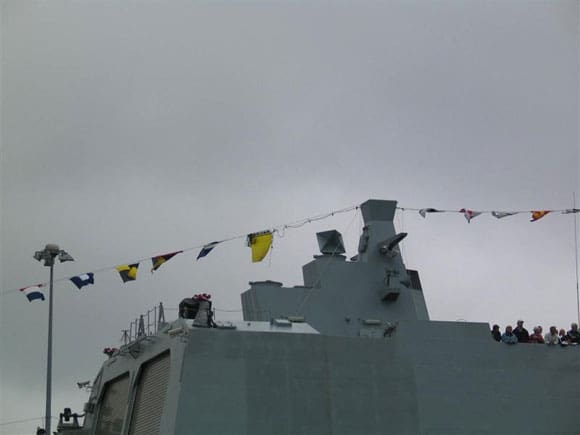
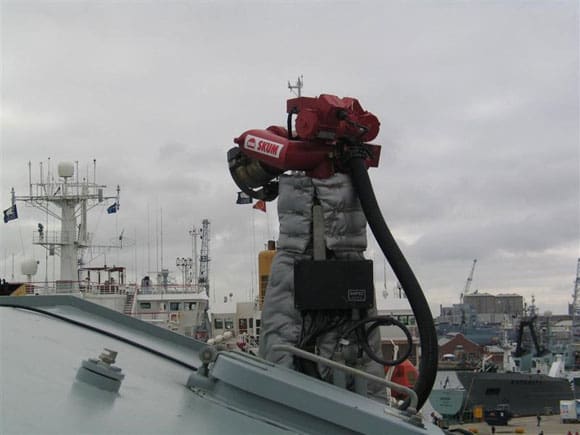
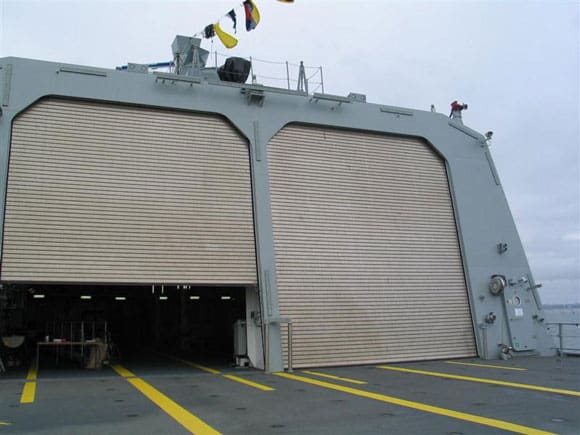
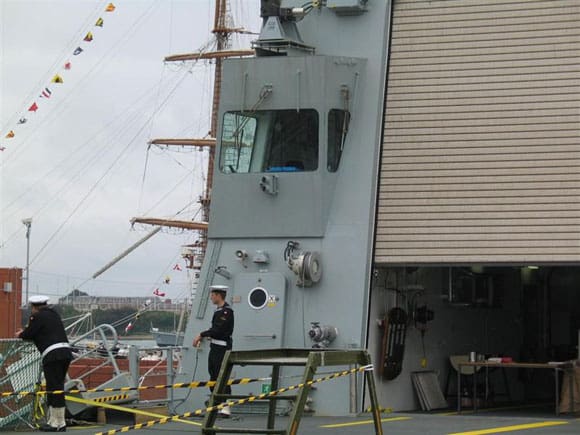
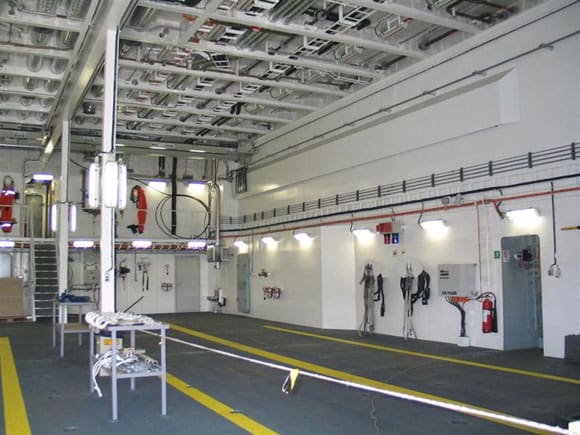
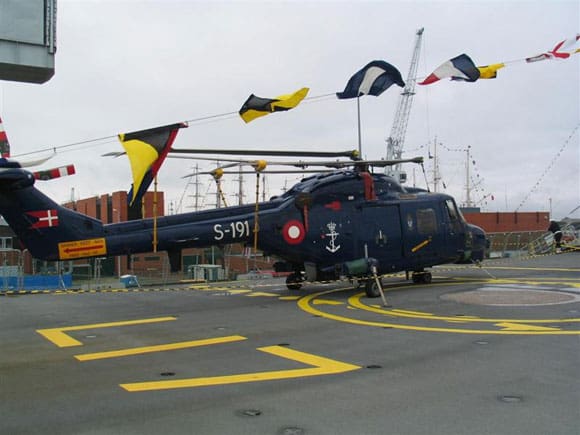
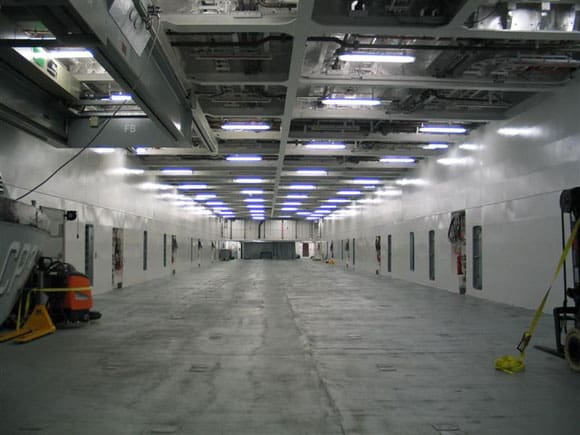
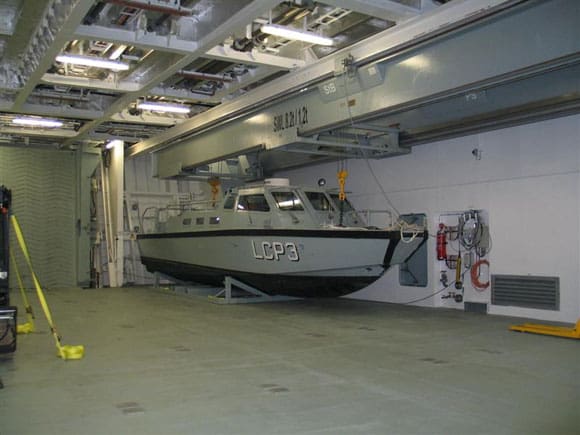
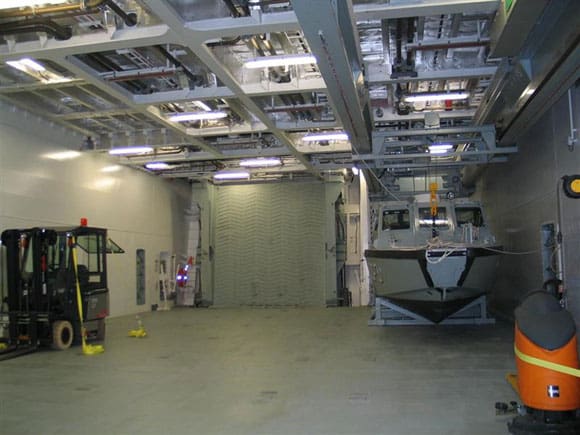
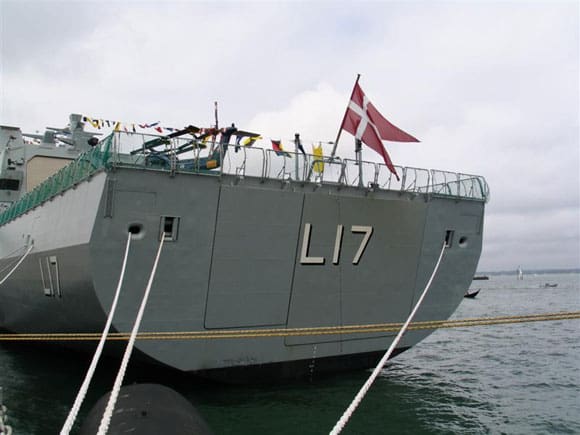
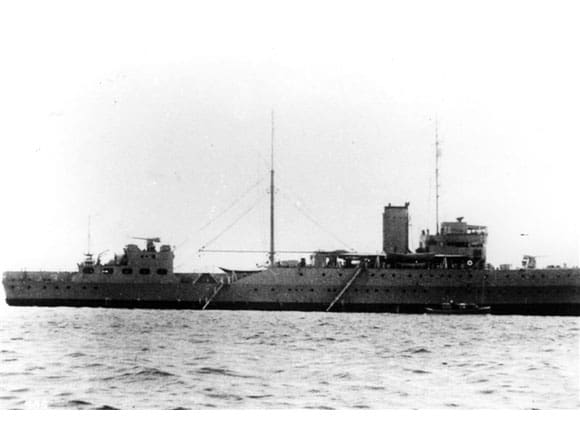
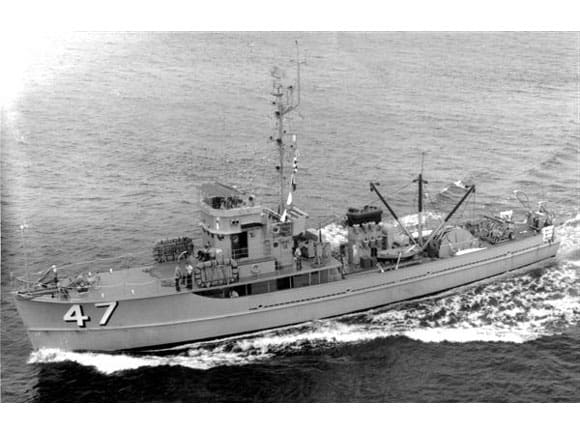
Pic 32:A contrast between the side of the superstructure and the openings. Pic 33:Position atop of the hanger. Pic 34:Fire fighting equipment sited atop of the hanger. Pic 35:An view of the spacious hanger from the flight deck. Pic 36:Flight Control position. Pic 37:Interior of the hanger, which can accommodate helicopters up to the size of the Merlin. Pic 38:Esbern Snare is equipped with the Lynx helicopter. Pic 39:The capacious cargo deck within the Esbern Snare. Pic 40:The LCP (Landing Craft Personnel) is deployed through an opening in the stern. Pic 41:The Ro–Ro door. Pic 42:The clear outline of the two stern openings. Pic 43:Mystery Picture. Pic 44:What Type of ship are we looking at?
Mystery Picture – Photo 43
Can you put a name to this ship? The clue is ‘nets’.
What type of ship are we looking at – Photo 44?
Clue is ‘YMS’.
References and Acknowledgements
Esbern Snare, ref. Combat Fleets Of the World 2007-2008 Jane’s Fighting Ships 2007-2008
HMS Iveston, ref. Mine Warfare Vessels of the Royal Navy 1908 – To Date, by MP Cocker, ‘The Ton Class’ pages100-103. ISBN 1853103284.
British Warships since 1945, Part 4 Minesweepers, by Jack Worth, page 99 (potted service history).
HMS London, ref. Jane’s 1948 Edition, page 41.
Royal Navy Warships 1939 – 1945 by WDG Blundell, page 39. ISBN 0855240342.
Cruisers of WWII. An International Encyclopedia by MJ Whitley, pages 87 – 90. ISBN 1860198740.
Bill Clarke/Nobie Smith (Atlantic Fleet sales).



